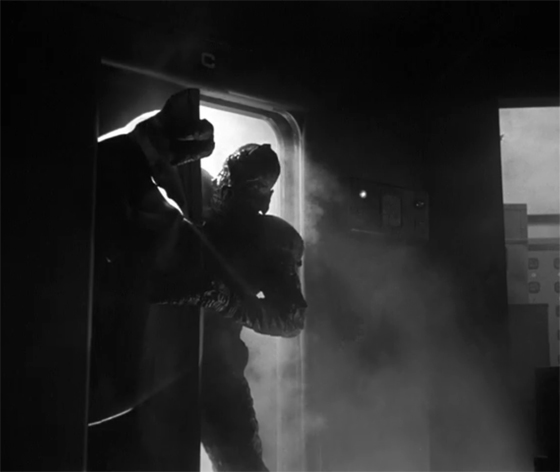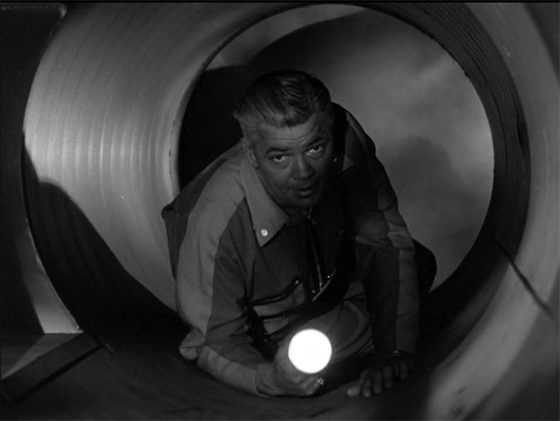
Forbidden Planet (1956) was the exception. Most science fiction films of the 50’s were on a shoestring budget, with simple special effects and acres of stiff dialogue delivered by hard-nosed military men and demure female scientists. There were two principal genres: the giant monster, mutated by nuclear experiments, and the exploration of outer space. The latter category would seem, on the surface, the more optimistic, inspired as it was by the burgeoning space race; but many of those movies were strictly downers – like Rocketship X-M (1950), which demonstrated the perils of space travel by killing off its entire cast. When the UFO craze arrived, Hollywood responded with movies like The Thing from Another World (1951), Earth vs. the Flying Saucers (1956), and Unidentified Flying Objects: The True Story of Flying Saucers (1956); extraterrestrial life seemed increasingly mysterious and frightening. It! The Terror from Beyond Space (1958) seemed like just another entry in the alien invasion subgenre, with another slim budget amped-up by some William Castle-style ballyhoo: the poster proclaimed, “$50,000 Guaranteed! by a world-renowned insurance company to the first person who can prove ‘It’ is not on Mars now!” But the grim efficiency of this modest thriller proved to be a major asset. With a high body count and a claustrophobic setting, the film has established a reputation as an early classic of what would come to be a popular genre mash-up, “science fiction horror.”

Two crew members take a spacewalk to access the rocket's lower decks.
Most famously, Dan O’Bannon’s screenplay for Ridley Scott’s Alien (1979) owes an obvious debt to It! The Terror from Beyond Space. Both films share the same basic premise: a crew onboard a spaceship come to the realization that they’ve taken on a stowaway, a lethal alien creature that destructively takes up residence inside the ship, killing them off one-by-one. The strengths of Scott’s film lie in his attention to convincing detail, as well as, of course, the almost unbearable suspense he manages to generate. But a 1950’s B-movie can’t be held to the same standards; science fiction was still a disreputable genre, the domain of pulp racks, and stuff best suited for children. Neither was there any great auteur behind the film; the similar The Thing from Another World was a better movie, but it benefited from producer Howard Hawks’ quality control (the script and acting compensate for its budgetary limitations). No, It! has just one ace in the hole: a crackerjack idea. As the film opens, our protagonist, Col. Carruthers (Marshall Thompson, Fiend Without a Face) is being delivered back to Earth following a disastrous mission on Mars. He’s accused of murdering his crew, of whom he’s the only survivor. The colonel’s story is so vague – not even he is entirely sure what transpired – that it hardly helps his cause. But the audience glimpses a menacing silhouette creeping onto the cargo bay of the rocket just before it departs the planet, and so we can solve the mystery pretty damn quickly. It’s not long before shipmates begin vanishing, and Carruthers, witnessing history repeat itself, insists upon a thorough search of the ship. They discover a hulking, humanoid alien with giant claws, a bat-like face, and ferocious strength. While it digs its way from one deck to the next – vertically up the rocketship – the survivors find themselves with less space to hide. Bullets and grenades are deployed with an alarming casualness, but they do no harm to the creature. Will the solution come before it breaks down that last door?

A confrontation with the creature in a ventilation shaft foreshadows Ridley's Scott's "Alien."
If I were to pinpoint one key to this modest thriller’s success, it would be the hopelessness of the situation. The alien creature is a Superman whose skin can’t be penetrated. Over the film’s 69-minute running time, relentlessly “It” pushes the crew into a corner. An effective little sequence more directly foreshadows Alien when, after they discover a body in a ventilation shaft, one of the men ventures inside and encounters the creature crawling through the tight space. Eventually two of the men take a spacewalk to access the rocket’s lower decks, attempting to circumvent the beast, but instead encountering it in close quarters, as one desperately wards him off with a blowtorch. (Anyone who’s seen Alien should be screaming at the screen to blast the creature out of the airlock.) Most films of this type are slowly-paced – special effects cost money, after all, so best use them sparingly. But once It! gets going, replacing its Wrong Man setup with monster movie horror, the action clips along nicely. It’s a formula that worked so well that Hollywood has yet to let it go. Though I think I know of two Martian rovers that would like to claim their $50,000 check – is that offer still valid?









